Tools for Chopping
The ax is a traditionally American handtool that has been used from Colonial times. Different head patterns distinguish axes from different regions.
Axes are of two basic types—single or double bit. Single-bit axes have one cutting edge opposite a flat face. Double-bit axes have two symmetrically opposed cutting edges. The single-bit ax is used when safety is paramount. Some workers prefer the double-bit ax. One edge is maintained at razor sharpness and the other is kept somewhat duller for chopping around rocks or dirt. Mark the duller edge with a spot of paint.
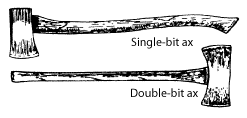
Modern axes incorporate many variations in handle length and head weights. Handles range from 32 to 36 inches, and heads from 2 to 4 pounds. A wide variety of head patterns is available. Broadaxes are used for hewing bridge timbers. If properly used and maintained, axes are effective for removing downfall, trimming limbs along a trail, and for felling. The flat end of a single bit may be used occasionally to pound stakes or wedges, but it is not designed for heavy use. Prolonged use for pounding will loosen the head, chip the face because it is not hardened like a hammer face, and warp the eye, causing problems with rehandling and balance.
Before chopping, check for adequate swing clearance and remove underbrush and overhanging branches that might interfere. Be sure your footing is stable and secure. Chop only when you are clear of other workers. Stand comfortably with your weight evenly distributed and both feet planted shoulder-width apart. Measure the correct distance to stand from the cut by holding the handle near the end and stretching your arms out toward the cut. You should be able to touch the blade to the cut. Begin chopping by sliding your forward hand within 6 inches of the head. As you swing, your forward hand slides back down the handle to the other hand. Just after impact, give the handle a slight twist to pop severed wood out of the cut.

Ax head types
Proficiency with axes requires practice. In general, the force of the swing is not as important as accurate placement. You should learn to "switch hit" with the ax, alternating your forward hand on the handle between chops while maintaining a firm grip with the other.
Always chop away from your body. Stand so a glancing blow won't strike you. If you must cut toward yourself, "choke up" on the handle with both hands and use short swings to give more control.
Chopping through a log requires a cut width twice the log's diameter to prevent the sides from converging before you are through. If opposing cuts are used, make each as wide as the log's diameter.
When limbing, cut on the underside of limbs and not in the crotch. Fewer chops are required and there is less chance that the ax will wedge between the branch and trunk or glance off. You are also more likely to chip blades because crotch wood is dense. When chopping branches above the crotch, place something solid under the chopping point to prevent the branch from springing back and slapping you.
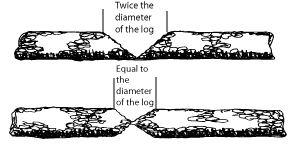
Chopping through logs

Using an ax for limbing
Carry axes by your side with the head forward. Grasp the handle firmly just behind the head and keep the cutting edge away from your body and down. Sheath all axes before transporting.
When sharpening, consider the job at hand. If you must reshape the blade, maintain the original shape as much as possible. Discard axes with poor profiles or cracked heads. Grind the blade slowly, arcing with the grinder toward the blade's midpoint so it has a full-width convex bevel. Be careful not to hollow grind blades, which produces a concave blade bevel the radius of the grinding wheel. Finish with a mill bastard file and an ax stone.
When sharpening in the field, secure the ax so both hands are free. A double-bit can be lodged in a tree stump or log, and a single-bit can be secured with the butt end in a V- notch. Wear gloves on both hands, and use a file guard on the file. Finish with an ax stone.
An Ax to Grind: A Practical Ax Manual (Tech. Rep. 9923-2823-MTDC), by Bernie Weisgerber, is a practical and detailed handbook about axes, their history, and their continuing use.
Many trail workers include hand axes or hatchets among their tools. Hatchets work well for trimming small green stems or freshening blaze markers along the trail. They are easily and safely carried in belt-mounted sheaths.
Hatchet heads are usually made of heat-treated steel designed to accept wood or fiberglass handles. Some have a steel handle forged to the head. They can weigh from 1 to 3 pounds and handles range from 10 to 16 inches long.

Use and maintain hatchets like regular axes. Remember that these tools are not designed for excessive pounding. Additional hazards may also exist for users because hatchets are single-grip tools.
Examples:

A sportsman's ax has the blade and handle forged
from one-piece
steel.
The length is 13½ inches
and the blade is 3¼ inches. Weight
is 24 ounces.
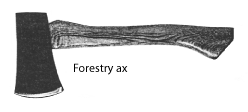
The forestry ax has a 1¼-pound head, 14-inch
hickory
handle, and weighs 1¾ pounds.

The tree-sounding ax has a ½-pound head that
is designed
for "sounding" trees. Foresters like
its
small
size (10 inches
long; 2½-inch blade)
for
carrying in a
vest or jacket pocket.
Weight is 1 pound.
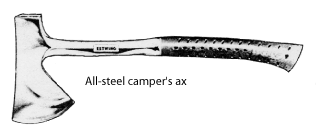
An all-steel camper's ax is 16 inches long and is forged
from
one-piece steel. It has a 4-inch blade, and
weighs 2¾ lbs.
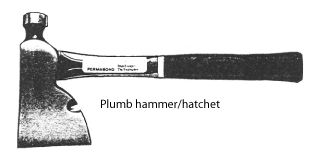
A plumb hammer/hatchet is a half-hatchet with hardened,
tempered bit and a strong fiberglass handle. It has a 3- to
4-inch bit,
is about 13½ inches long, and weighs 2½ lbs.


